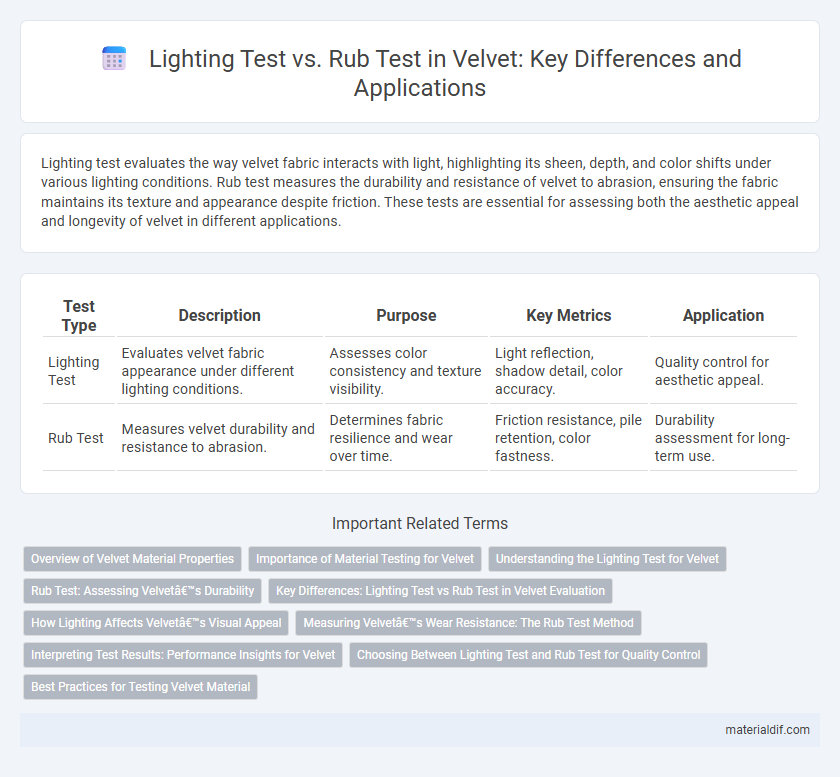Lighting test evaluates the way velvet fabric interacts with light, highlighting its sheen, depth, and color shifts under various lighting conditions. Rub test measures the durability and resistance of velvet to abrasion, ensuring the fabric maintains its texture and appearance despite friction. These tests are essential for assessing both the aesthetic appeal and longevity of velvet in different applications.
Table of Comparison
| Test Type | Description | Purpose | Key Metrics | Application |
|---|---|---|---|---|
| Lighting Test | Evaluates velvet fabric appearance under different lighting conditions. | Assesses color consistency and texture visibility. | Light reflection, shadow detail, color accuracy. | Quality control for aesthetic appeal. |
| Rub Test | Measures velvet durability and resistance to abrasion. | Determines fabric resilience and wear over time. | Friction resistance, pile retention, color fastness. | Durability assessment for long-term use. |
Overview of Velvet Material Properties
Velvet is characterized by its dense pile and soft texture, which creates a luxurious appearance with varying light reflection. The Lighting Test highlights velvet's ability to reflect and absorb light, emphasizing its depth and richness under different lighting conditions. The Rub Test demonstrates velvet's pile resilience, showing how repeated friction affects its softness and sheen, essential for assessing durability in upholstery and apparel.
Importance of Material Testing for Velvet
Material testing for velvet is crucial to ensure the fabric's durability, texture, and aesthetic quality under different conditions. Lighting tests evaluate velvet's colorfastness and sheen by simulating exposure to various light sources, preventing fading or discoloration. Rub tests assess the fabric's resistance to abrasion, guaranteeing its softness and appearance endure during regular use.
Understanding the Lighting Test for Velvet
The Lighting Test for velvet evaluates how light interacts with the fabric's pile, highlighting variations in texture and sheen based on fiber direction and density. This test is crucial for quality control, ensuring consistent surface appearance under different lighting conditions by assessing reflection, shadow depth, and color richness. Understanding these optical effects helps manufacturers optimize velvet production for luxury textiles with vibrant, durable finishes.
Rub Test: Assessing Velvet’s Durability
Rub tests evaluate velvet's durability by measuring its resistance to abrasion and colorfastness under repeated friction. This method simulates real-life wear, helping manufacturers and consumers understand how velvet maintains texture and appearance over time. The results of rub tests provide critical insights into velvet's longevity, guiding quality control and fabric selection for upholstery, fashion, and home decor.
Key Differences: Lighting Test vs Rub Test in Velvet Evaluation
Lighting Test in velvet evaluation examines surface appearance under various light conditions to detect sheen, texture, and color consistency, highlighting how velvet reacts to directional lighting. Rub Test assesses velvet durability and colorfastness by simulating wear and friction, revealing resistance to pilling, fading, and fabric distortion. Key differences lie in Lighting Test focusing on visual aesthetics and reflective properties, while Rub Test emphasizes physical resilience and long-term fabric performance.
How Lighting Affects Velvet’s Visual Appeal
Lighting significantly influences velvet's texture and richness, enhancing its soft pile and depth of color through a lighting test that reveals subtle sheen and shadow contrasts. In comparison, a rub test demonstrates how velvet's fibers react to touch and movement, altering its appearance by shifting light reflection and creating dynamic patterns. Optimal lighting can amplify velvet's luxurious visual appeal, highlighting its plush surface and creating an immersive sensory experience.
Measuring Velvet’s Wear Resistance: The Rub Test Method
The Rub Test is a critical method for measuring velvet's wear resistance, evaluating how well the fabric maintains texture and color after repetitive friction. Unlike the Lighting Test, which assesses surface luster under varied illumination, the Rub Test simulates real-life abrasion to quantify velvet's durability. This method provides precise data on fabric resilience, essential for quality control in textile manufacturing and upholstery applications.
Interpreting Test Results: Performance Insights for Velvet
Lighting tests on velvet assess how fabric reflects and absorbs light, revealing sheen intensity and texture depth crucial for aesthetic appeal. Rub tests evaluate durability by simulating wear, measuring colorfastness and pile resilience to predict long-term performance. Combining both tests provides comprehensive insights into velvet's visual quality and durability, guiding optimal fabric selection for high-end upholstery and fashion applications.
Choosing Between Lighting Test and Rub Test for Quality Control
Lighting tests evaluate velvet's surface texture and pile consistency by assessing light reflection and shadow play, revealing flaws like uneven nap or color variation. Rub tests measure velvet's durability and resistance to wear by simulating friction, identifying issues such as pile distortion or fabric damage. Selecting between the two depends on whether emphasis is on aesthetic appearance or functional resilience in quality control processes.
Best Practices for Testing Velvet Material
Testing velvet fabric involves two primary methods: the Lighting Test and the Rub Test. The Lighting Test evaluates how light interacts with the velvet's pile, revealing color depth and texture variations essential for quality assessment. The Rub Test assesses durability and pile resilience by observing changes after simulated wear, ensuring the velvet maintains its luxurious appearance and softness over time.
Lighting Test vs Rub Test Infographic

 materialdif.com
materialdif.com